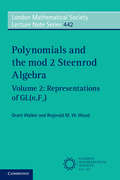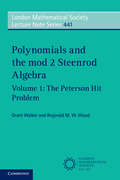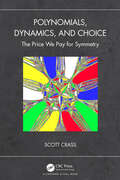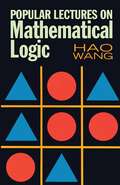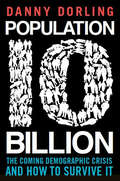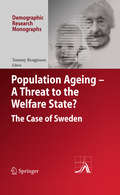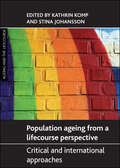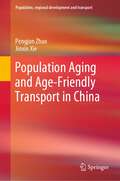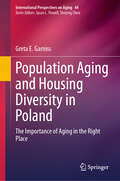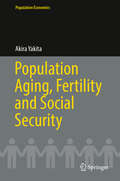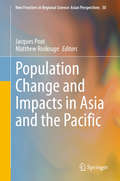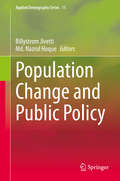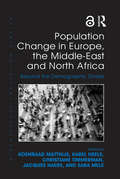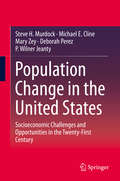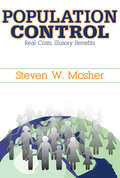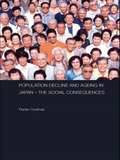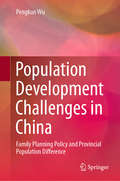- Table View
- List View
Polynomials and the mod 2 Steenrod Algebra: Representations of GL (London Mathematical Society Lecture Note Series #442)
by Grant Walker Reginald M. W. WoodThis is the first book to link the mod 2 Steenrod algebra, a classical object of study in algebraic topology, with modular representations of matrix groups over the field F of two elements. The link is provided through a detailed study of Peterson's `hit problem' concerning the action of the Steenrod algebra on polynomials, which remains unsolved except in special cases. The topics range from decompositions of integers as sums of 'powers of 2 minus 1', to Hopf algebras and the Steinberg representation of GL(n, F). Volume 1 develops the structure of the Steenrod algebra from an algebraic viewpoint and can be used as a graduate-level textbook. Volume 2 broadens the discussion to include modular representations of matrix groups. Algebraic and combinatorial treatment of Steenrod algebra. Accessible to those without a background in topology. Largely self-contained with detailed proofs.
Polynomials and the mod 2 Steenrod Algebra: The Peterson Hit Problem (London Mathematical Society Lecture Note Series #441)
by Grant Walker Reginald M. W. WoodThis is the first book to link the mod 2 Steenrod algebra, a classical object of study in algebraic topology, with modular representations of matrix groups over the field F of two elements. The link is provided through a detailed study of Peterson's 'hit problem' concerning the action of the Steenrod algebra on polynomials, which remains unsolved except in special cases. The topics range from decompositions of integers as sums of 'powers of 2 minus 1', to Hopf algebras and the Steinberg representation of GL(n,F). Volume 1 develops the structure of the Steenrod algebra from an algebraic viewpoint and can be used as a graduate-level textbook. Volume 2 broadens the discussion to include modular representations of matrix groups.
Polynomials, Dynamics, and Choice: The Price We Pay for Symmetry
by Scott CrassWorking out solutions to polynomial equations is a mathematical problem that dates from antiquity. Galois developed a theory in which the obstacle to solving a polynomial equation is an associated collection of symmetries. Obtaining a root requires "breaking" that symmetry. When the degree of an equation is at least five, Galois Theory established that there is no formula for the solutions like those found in lower degree cases. However, this negative result doesn't mean that the practice of equation-solving ends. In a recent breakthrough, Doyle and McMullen devised a solution to the fifth-degree equation that uses geometry, algebra, and dynamics to exploit icosahedral symmetry.Polynomials, Dynamics, and Choice: The Price We Pay for Symmetry is organized in two parts, the first of which develops an account of polynomial symmetry that relies on considerations of algebra and geometry. The second explores beyond polynomials to spaces consisting of choices ranging from mundane decisions to evolutionary algorithms that search for optimal outcomes. The two algorithms in Part I provide frameworks that capture structural issues that can arise in deliberative settings. While decision-making has been approached in mathematical terms, the novelty here is in the use of equation-solving algorithms to illuminate such problems.Features Treats the topic—familiar to many—of solving polynomial equations in a way that’s dramatically different from what they saw in school Accessible to a general audience with limited mathematical background Abundant diagrams and graphics.
Popular Lectures on Mathematical Logic
by Hao WangA noted logician and philosopher addresses various forms of mathematical logic, discussing both theoretical underpinnings and practical applications. Author Hao Wang surveys the central concepts and theories of the discipline in a historical and developmental context, and then focuses on the four principal domains of contemporary mathematical logic: set theory, model theory, recursion theory and constructivism, and proof theory.Topics include the place of problems in the development of theories of logic and logic's relation to computer science. Specific attention is given to Gödel's incompleteness theorems, predicate logic and its decision and reduction problems, constructibility and Cantor's continuum hypothesis, proof theory and Hilbert's program, hierarchies and unification, proof of the four-color problem, the Diophantine problem, the tautology problem, and many other subjects. Three helpful Appendixes conclude the text.
Population 10 Billion
by Danny DorlingBefore May 2011 the top demographics experts of the United Nations had suggested that world population would peak at 9.1 billion in 2100, and then fall to 8.5 billion people by 2150. In contrast, the 2011 revision suggested that 9.1 billion would be achieved much earlier, maybe by 2050 or before, and by 2100 there would be 10.1 billion of us. What's more, they implied that global human population might still be slightly rising in our total numbers a century from now. So what shall we do? Are there too many people on the planet? Is this the end of life as we know it?Distinguished geographer Professor Danny Dorling thinks we should not worry so much and that, whatever impending doom may be around the corner, we will deal with it when it comes. In a series of fascinating chapters he charts the rise of the human race from its origins to its end-point of population 10 billion. Thus he shows that while it took until about 1988 to reach 5 billion we reached 6 billion by 2000, 7 billion eleven years later and will reach 8 billion by 2025. By recording how we got here, Dorling is able to show us the key issues that we face in the coming decades: how we will deal with scarcity of resources; how our cities will grow and become more female; why the change that we should really prepare for is the population decline that will occur after 10 billion.Population 10 Billion is a major work by one of the world's leading geographers and will change the way you think about the future. Packed full of counter-intuitive ideas and observations, this book is a tool kit to prepare for the future and to help us ask the right questions
Population 10 Billion
by Professor Danny DorlingBefore May 2011 the top demographics experts of the United Nations had suggested that world population would peak at 9.1 billion in 2100, and then fall to 8.5 billion people by 2150. In contrast, the 2011 revision suggested that 9.1 billion would be achieved much earlier, maybe by 2050 or before, and by 2100 there would be 10.1 billion of us. What's more, they implied that global human population might still be slightly rising in our total numbers a century from now. So what shall we do? Are there too many people on the planet? Is this the end of life as we know it?Distinguished geographer Professor Danny Dorling thinks we should not worry so much and that, whatever impending doom may be around the corner, we will deal with it when it comes. In a series of fascinating chapters he charts the rise of the human race from its origins to its end-point of population 10 billion. Thus he shows that while it took until about 1988 to reach 5 billion we reached 6 billion by 2000, 7 billion eleven years later and will reach 8 billion by 2025. By recording how we got here, Dorling is able to show us the key issues that we face in the coming decades: how we will deal with scarcity of resources; how our cities will grow and become more female; why the change that we should really prepare for is the population decline that will occur after 10 billion.Population 10 Billion is a major work by one of the world's leading geographers and will change the way you think about the future. Packed full of counter-intuitive ideas and observations, this book is a tool kit to prepare for the future and to help us ask the right questions
Population Ageing - A Threat to the Welfare State?: The Case of Sweden
by Tommy BengtssonThis book is the first to take a comprehensive view of the challenges that population ageing present in the near future taking Sweden as the case. Can the increasing number of retirees per worker be stopped by immigration or increasing fertility or will we need to increase pension age instead? Cost for the social-care system is readily increasing; even more is the costs for health care. Can the galloping costs be funded by an increase in taxes or do we need to make reforms, similar to the ones already made in the pension system, which has been used as a model for many other countries. The fact that it is difficult to make health care dependent on personal contributions, as is the case of the pension system, funding of health care is a true test of solidarity across generations. The book ends with a discussion on whether the demographic challenge to the welfare system is also a threat to the welfare state as such.
Population Ageing from a Lifecourse Perspective: Critical and International Approaches (Ageing and the Lifecourse)
by Edited by Kathrin Komp and Stina JohanssonPopulations around the globe are ageing rapidly. This demographic shift affects families, market structures and social provisions. This timely volume, part of the Ageing and the Lifecourse series, argues that the lifecourse perspective helps us understand the causes and effects of population ageing. The lifecourse perspective suggests that individuals’ experiences at an early age can influence their decisions and behaviour at a later age. This much-needed volume combines insights from different disciplines and real-life experiences to describe the theories and practices behind this idea. It therefore caters to the needs of scholars, practitioners and policy makers in a range of areas including sociology and political science.
Population Aging and Age-Friendly Transport in China (Population, Regional Development and Transport)
by Pengjun Zhao Jinxin XieThis book is the first book that investigates aging and its impacts on transport system in China. Using various data, this book covers, but is not limited to, the development of population aging, the changes of travel demand, the features of travel behavior of China’s elderly, progress and prospect of age-friendly transport in China. The book has international academic novelty in three points. Firstly, it discovers the long-term supply-demand relationship between population aging and transport infrastructure development. Secondly, it finds the changes and factors in travel behavior of the elderly people. Thirdly, it discusses the advantages or disadvantages of age-friendly transport policy. The findings in the book provide fresh evidences for the challenges posed by aging to transport and enhance readers’ existing knowledge of the elderly people’s travel behavior and the related determinants. These findings are helpful for planners and politicians to make age-friendly transport policies and useful for investors and enterprises to supply proper transport services to the elderly people. This book is of great interest to scholars and practitioners interested in transport development, transport policy, social transition, sustainable mobility, urban planning, urban governance and is relevant to China and other developing countries.
Population Aging and Housing Diversity in Poland: The Importance of Aging in the Right Place (International Perspectives on Aging #44)
by Greta E. GarnissThis book provides new and original insight on the senior living housing needs in Poland. It focuses on housing needs of the 60-74 age group that are generally more mobile and not in need of services offered in care homes. The book not only shows that seniors prefer to live independently as long as possible, but also touches upon their primary conditions for this, such as properties near goods, services and social networks, in modern buildings that have common amenities that meet their needs as they age. The book also discusses the transformation of economic, social and cultural changes leading to the creation of a new housing options for younger seniors living in many cities in Poland. With the book concluding that there is need for more diverse housing choice for senior living than is currently available, it provides an interesting read for academics, professionals and local, regional and national social service agencies that work with seniors.
Population Aging, Fertility and Social Security
by Akira YakitaThis book provides a comprehensive, theory-based analysis of current issues in population economics. It addresses the most important problems caused by demographic changes using the popular overlapping generations growth model by Samuelson and Diamond. Taking into account families' fertility decisions, it examines not only the demographic changes due to longer life expectancy but also the effects of social security policy on demography and labor supply/individual retirement behaviors. Conducting all analyses in a dynamic general equilibrium setting, the book offers a valuable theoretical reference guide in the field of population economics.
Population Change and Impacts in Asia and the Pacific (New Frontiers in Regional Science: Asian Perspectives #30)
by Jacques Poot Matthew RoskrugeThis volume brings together a range of contributions that provide contemporary regional science perspectives on population change and its socio-economic consequences in the Asia-Pacific region. This region accounts for close to two-thirds of the world’s population and is highly diverse in terms of key demographic indicators such as population size, growth, composition and distribution. The authors provide quantitative assessments, either descriptively or by means of modelling, of important demographic issues affecting this part of the world.The topics addressed include: broad demographic trends across the Asia-Pacific region and its sub-regions; assessment of population decline, urbanization and spatial distribution using cases from China, Colombia, Japan and Australia; migration and economic impacts in Australasia, Chile and Timor Leste; and the impacts of declining or low fertility and population ageing in China, India, Thailand, and across Asia.Given its scope, the book will appeal to all readers seeking to understand population change and impacts across the Asia-Pacific region, with a specific focus on sub-regional differences and dynamics.
Population Change and Public Policy (Applied Demography Series #11)
by Billystrom Jivetti Md. Nazrul HoqueThis book provides a solid empirical portrait based on the complexities of demographic components of population change. It describes recent innovations, trends, challenges and solutions to population change and public policy issues, such as but not limited to immigration, gender discrimination in the labor market, student housing, teen pregnancy programs, smoking and alcohol consumption, and environment and self-rated health. As such it provides an interesting platform for academics, researchers, policy makers, and students to explore experiences and research findings on special topics in applied demography and how those inform the field of population studies and public policy.
Population Change in Europe, the Middle-East and North Africa: Beyond the Demographic Divide (International Population Studies)
by Christiane Timmerman Jacques Haers Koenraad Matthijs Karel NeelsCurrent demographic trends raise new questions, challenges and controversies. Comparing demographic trends in Europe and the NAME-region (North Africa and the Middle East), this book demonstrates how population change interacts with changing economic landscapes, social distinctions and political realities. A variety of drivers contribute to demographic change in the various regions and countries considered, such as family policies, economic realities, the impact of educational differentials and the attitudes towards marriage. On the macro-level the new trends are restructuring the age composition of populations and are reshaping the life courses of individuals and families. In turn, the impact demographic forces have on the organisation of labour markets, on fiscal policies, on the care of the elderly, on migration flows and on political changes can be quite radical. The volume provides food for thought for those who are looking for a nuanced perspective on the background and future perspectives of demographic developments in Europe, for a discussion of recent demographic and political realities in the NAME countries, and for those who analyse the effects of contrasting demographic regimes on migration flows to and migration politics in Europe. Chapter 1 of this book is freely available as a downloadable Open Access PDF at http://www.tandfebooks.com/page/openaccess. It has been made available under a Creative Commons Attribution-Non Commercial-No Derivatives 3.0 license.
Population Change in the United States
by Steve H. Murdock Michael E. Cline Mary Zey Deborah Perez P. Wilner JeantyThis new volume maps the complex interplay of demographic and socioeconomic changes in the United States, where rapid aging and ethnic diversification are merely the most salient of the many issues with major long-term implications. Drawing on The United States Census Bureau's post-2010 detailed projections, as well as a wealth of data distilled from authoritative sources, the authors tackle many of the urgent policy questions raised by America's changing population. The book explores the ways economic markets are adapting to an older and more diverse customer base, how the projected demographic change will impact public service demand, the growing economic disparities between asset-rich baby boomers and youth struggling for economic security, and how the projected demographic patterns will change the fiscal, economic, education, health, and housing sectors and alter the social structures and processes impacting American households and the diverse array of America's future population. A thorough survey of major demographic patterns in the USA up to 2050 is followed by an assessment of how these will affect socioeconomic, public service, fiscal, economic, and social structures and mechanisms, down to the size and composition of households. The analysis then considers possible variations of outcome predicated on alternative dynamic patterns between demographics and socioeconomics. Cutting through the politics and communal anxieties with hard, cutting-edge data, this study will be a primary source for all those who must use its contents to guide their decisions.
Population Control: Real Costs, Illusory Benefits
by Steven W. MosherFor over half a century, policymakers committed to population control have perpetrated a gigantic, costly, and inhumane fraud upon the human race. They have robbed people of the developing countries of their progeny and the people of the developed world of their pocketbooks. Determined to stop population growth at all costs, those Mosher calls "population controllers" have abused women, targeted racial and religious minorities, undermined primary health care programs, and encouraged dictatorial actions if not dictatorship. They have skewed the foreign aid programs of the United States and other developed countries in an anti-natal direction, corrupted dozens of well-intentioned nongovernmental organizations, and impoverished authentic development programs. Blinded by zealotry, they have even embraced the most brutal birth control campaign in history: China's infamous one-child policy, with all its attendant horrors. There is no workable demographic definition of "overpopulation." Those who argue for its premises conjure up images of poverty - low incomes, poor health, unemployment, malnutrition, overcrowded housing to justify anti-natal programs. The irony is that such policies have in many ways caused what they predicted - a world which is poorer materially, less diverse culturally, less advanced economically, and plagued by disease. The population controllers have not only studiously ignored mounting evidence of their multiple failures; they have avoided the biggest story of them all. Fertility rates are in free fall around the globe. Movements with billions of dollars at their disposal, not to mention thousands of paid advocates, do not go quietly to their graves. Moreover, many in the movement are not content to merely achieve zero population growth, they want to see negative population numbers. In their view, our current population should be reduced to one or two billion or so. Such a goal would keep these interest groups fully employed. It would also have dangerous consequences for a global environment.
Population Decline and Ageing in Japan - The Social Consequences (Routledge Contemporary Japan Series)
by Florian CoulmasThis book presents a comprehensive analysis of one of the most pressing challenges facing Japan today: population decline and ageing. It argues that social ageing is a phenomenon that follows in the wake of industrialization, urbanization and social modernization, bringing about changes in values, institutions, social structures, economic activity, technology and culture, and posing many challenges for the countries affected. Focusing on the experience of Japan, the author explores: how Japan has recognized the emerging problems relatively early because during the past half century population ageing has been more rapid in Japan than in any other country how all of Japanese society is affected by social ageing, not just certain substructures and institutions, and explains its complex causes, describes the resulting challenges and analyses the solutions under consideration to deal with it the nature of Japan’s population dynamics since 1920, and argues that Japan is rapidly moving in the direction of a ‘hyperaged society’ in which those sixty-five or older account for twenty-five per cent of the total population the implications for family structures and other social networks, gender roles and employment patterns, health care and welfare provision, pension systems, immigration policy, consumer and voting behaviour and the cultural reactions and ramifications of social ageing.
Population Development Challenges in China: Family Planning Policy and Provincial Population Difference
by Pengkun WuThis book explores the population development challenges in China. It started by analyzing two of the major challenges: designing a suitable family planning policy and dealing with the serious provincial population difference. It then proposes effective measures to address these challenges by adopting various quantitative methods, such as system dynamics, nonlinear programming and spatial econometrics in evaluating the effects of different policy scenarios, which made the results more scientific and reliable, thus the final policy suggestions effective and evidence based. The book includes a number of mathematical models and is suitable for graduate students and researchers in population modeling and relevant research areas.
Population Dynamics Based on Individual Stochasticity (SpringerBriefs in Population Studies)
by Ryo OizumiThis book demonstrates that population structure and dynamics can be reconstructed by stochastic analysis. Population projection is usually based on age-structured population models. These models consist of age-dependent fertility and mortality, whereas birth and death processes generally arise from states of individuals. For example, a number of seeds are proportional to tree size, and amount of income and savings are the basis of decision making for birth behavior in human beings. Thus, even though individuals belong to an identical cohort, they have different fertility and mortality. To treat this kind of individual heterogeneity, stochastic state transitions are reasonable rather than the deterministic states. This book extends deterministic systems to stochastic systems specifically, constructing a state transition model represented by stochastic differential equations. The diffusion process generated by stochastic differential equations provides statistics determining population dynamics, i.e., heterogeneity is incorporated in population dynamics as its statistics. Applying this perspective to demography and evolutionary biology, we can consider the role of heterogeneity in life history or evolution. These concepts are provided to readers with explanations of stochastic analysis.
Population Dynamics Of Senegal
by Working Group on SenegalThis volume, the last in the series Population Dynamics of Sub-Saharan Africa, examines key demographic changes in Senegal over the past several decades. It analyzes the changes in fertility and their causes, with comparisons to other sub-Saharan countries. It also analyzes the causes and patterns of declines in mortality, focusing particularly on rural and urban differences.
Population Dynamics and Livelihood Changes of Small-Scale Societies in Laos (International Perspectives in Geography #22)
by Satoshi Yokoyama Takahito Niwa Hongwei JiangThis book examines various trends in small-scale societies in Laos by linking population changes to livelihood changes. The primary research issues addressed in the book are as follows: ・ How are population dynamics and livelihood changes in small-scale societies interrelated? ・ What are the current demographic trends in rural areas of Laos? ・ How are the livelihoods of small-scale societies maintained? ・ How is the rapid population growth common in developing countries managed? In order to investigate these issues in developing countries where statistical data are not well developed, it was necessary to collect information through detailed and distinctive fieldwork. To this end, a multidisciplinary study of geography, cultural anthropology, human ecology, and demography was conducted in three villages in Laos and compiled as an ethnography. The study included a four-generation retrospective survey of population and land use change, a two-year survey of food dairies, and a survey of the spatiotemporal distribution of residents' daily activities using GIS and GPS, etc. The book provides valuable information on the slowdown in the rate of population growth in contemporary rural Laos. Livelihoods, family planning and population migration are explored in the context of the decreasing population growth rate. In addition, the book describes the process of adopting modern contraceptive methods in rural areas, as well as the Lao government's reproductive policies and villagers' responses to them. It also illustrates rural–rural and rural–urban population migration influenced by the government's resettlement policies, which encourages people to move from the highlands to the lowlands.
Population Dynamics and Projection Methods
by John Stillwell Martin ClarkeAlthough the human population growth rate of the world has been declining since peaking in the early 1960s, the populations of individual countries are changing at different rates. Population dynamics at national level are partly determined by levels of fertility and mortality, but the impact of international migration is playing an increasingly important role. Moreover, internal migration plays a major part in population change at the sub-national level. This fourth volume in the series "Understanding Population Trends and Processes" is a celebration of the work of Professor Philip Rees. It contains chapters by contributors who have collaborated with Phil Rees on research or consultancy projects or as postgraduate students. Several chapters demonstrate the technical nature of population projection modelling and simulation methods while others illustrate issues relating to data availability and estimation. This book demonstrates the application of theoretical and modelling methods and addresses key issues relating to contemporary demographic patterns and trends.
Population Dynamics in Contemporary South Asia: Health, Education and Migration
by Anuradha Banerjee Vinod Kumar Mishra Narayan Chandra JanaThis book discusses the sequential development of population research in India, focusing on contemporary issues like demography, population studies, geography, sociology, urban studies and many more. It describes the problems related to the underdeveloped regions in India, Nepal and Bangladesh and includes tabular representations of the analyzed data as well as visual representations/illustrations in the form of graphs and maps. Further, it features fascinating case studies on primary field-research experiences. Presenting interdisciplinary contributions, the book is divided into four sections: the first part examines social issues related to health, while the second explores social sustainability, lifestyles, and cultural aspects. The third and fourth sections address migration and quality of life, respectively. The book is of interest to students studying demography, as well as researchers and policymakers in the fields of population studies, geography and sociology.
Population Dynamics in Eastern India and Bangladesh: Demographic, Health and Developmental Issues
by Aparajita Chattopadhyay Saswata GhoshThis book highlights historical and current perspectives on population issues in the Bengali-speaking states of India (i.e., West Bengal, Tripura, Assam) and Bangladesh and explores three core population dynamics: fertility, mortality–morbidity and development. Furthermore, it presents a selection of revealing cases from area-specific micro-studies, mainly conducted in West Bengal and Bangladesh. The book covers various demographic and health issues in these two regions, which are similar in terms of several sociocultural aspects, yet dissimilar in terms of their policies and programs. Adopting an integrated approach that combines various disciplines and perspectives, it explores highly topical issues such as social inequality, religious difference and mental health. The book is intended for a broad readership interested in population studies, sociology and development, including academics, researchers, planners and policymakers.
Population Dynamics in Muslim Countries
by Alfonso Sousa-Poza Hans GrothThe book discusses the demographic changes in Muslim countries. It thereby focuses on topics such as the demographic dividend and the demographic transition, labour market challenges, health care, universal education and gender issues. These challenges are addressed at a country level and include policy implications for the large majority of the Muslim countries covered in this book. Moreover, political consequences for Europe with respect to the integration of Muslims are presented to the reader.
